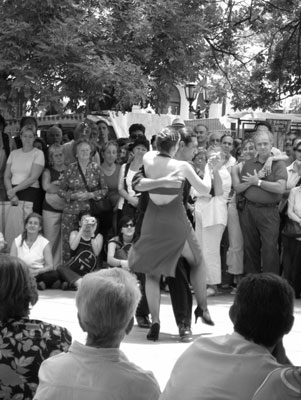Learning tango in BA
Tango in its various forms became a focal point of our December ’04 journey to Buenos Aires, Argentina. We have always enjoyed watching tango dancers and listening to tango music. We sought out tango lessons and tango salons, tango in the streets and tango in theater performances. And we never got our fill, as there are so many varieties. We decided that we did not want to do the usual tourist thing — a dinner show with professional tango dancers — but wanted to seek out Porteños (B.A. residents) dancing.
The second evening we were there, we read in Time Out Buenos Aires that we could see authentic tango danced at La Viruta (Armenia 1366 in Palermo Viejo). La Viruta is housed in the Armenian Cultural Center; many tango salons are in community centers. Entry cost about $3 per person.
We arrived around 10 p.m. and, to our delight, walked into a jitterbug lesson. The men were on one side of the floor with a male instructor and the women were on the other side with a female instructor. The ages and skill levels were decidedly mixed. We joined right in, not bothering with the lessons but dancing on the fringes. After about an hour, the tango dancing began and it was a joy to behold.
A few days later we had our tango lesson at Confiteria Ideal (348 Suipacha), about which we learned from a local guide. It cost about $3 per person for a lesson or salon. (The salon, or milonga, is a dance open to all where people of all ages tango. Sometimes they are in the afternoon, sometimes at night. The women are usually dressed nicely.)
The Confiteria Ideal dates from 1912. Amid the marble columns and under the chandeliers, instructors Eduardo and Marisa divided the group into beginners and experienced dancers. In both Spanish and English, they did a masterful job of teaching us the basic 8 step and the figure 8 variation. It was amazing to watch some of the more experienced dancers with their grace and sensuality.
We returned to the Ideal at 6 p.m. one Sunday. On the first floor were older adults sitting at tables, enjoying a drink or a coffee and dancing to tunes from the ’40s and ’50s. The women outnumbered the men, the average age was about 70 and all were having a wonderful time. But we had come for tango, so upstairs we went, where the tango salon was in progress.
Again, it was a treat to watch people of all shapes, sizes and ages simply enjoying a national passion. Regardless of their physical shapes, most of the women were dressed in outfits associated with tango, and they all looked beautiful. The men were more casually dressed in sport shirts and slacks. After a glass of wine, we had enough courage to go out on the floor and try out our newly learned 8 step and figure 8.
We had two other wonderful tango experiences. The first was a free concert at Teatro Coliseo featuring four bandoneón maestros, a violinist and a popular tango cantaro (singer). The bandoneón is the concertina-like instrument that is an integral part of tango music.
The tango songs are filled with love and laments. The audience obviously was familiar with all of the artists and applauded and cheered loudly after each performed. The music was wonderful and, even though we could not understand the Spanish lyrics, we knew we were sharing in a very special event. Before we left Buenos Aires, we purchased CDs of the musicians we’d heard.
We also watched tango dancers on the streets of San Telmo and La Boca. We saw a 13-year-old and his 16-year-old sister performing casually on one of the downtown plazas as we enjoyed a coffee. Yes, they needed some seasoning, but it was obvious that the tango is something they had grown up with and did quite naturally. All of the street dancers passed the basket and hoped onlookers would contribute.
MARSHA CAPLAN
Boulder, CO

